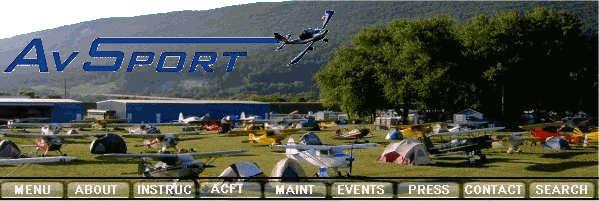
AvSport of Lock Haven -- 353 Proctor Street, Lock Haven PA 17745
Go-Around Unlikely
Excerpt from Winging It! With Dr. Paul: Forty Tales Your Flight Instructor Never Told You (copyright © 1989 by H. Paul Shuch)

Go-Around Unlikely
Excerpt from Winging It! With Dr. Paul: Forty Tales Your Flight Instructor Never Told You (copyright © 1989 by H. Paul Shuch)
"Here, let me take it," I said just as we turned downwind, "I want to show you something." Suk, my first and favorite student, instantly relinquished control. She had done a most credible job locating Harris Ranch by pilotage on this, her first dual cross-country. Now that she had the plane slowed down and the gear extended, I thought she could use a break. Besides, as happens to many instructors, I hadn't done a landing in a week, and relished any opportunity to get my hands on the controls.
To justify usurping her command, I set up for an obstacle approach, while Suk watched intently. Holding altitude on base, full flaps on final, slowed down behind the power curve, steeper than normal approach, decent rate controlled with throttle alone.
Only something was wrong. As I wound back the throttle knob, the manifold pressure never dropped below fifteen inches. The craft clawed its way toward an inevitable overshoot. "It's your plane," I told Suk, though never completely releasing the controls. "Go around!"
She handled it nicely. Go handles firewalled, yoke forward for airspeed, she eased off the first notch of flaps. Raising the gear only after establishing a positive rate of climb, she smoothly milked off the remaining flaps. Our climb performance, however, was less than stellar; full throttle was yielding only twenty inches on the M. P. gauge. Upon reaching pattern altitude, she eased back on the throttle - and nothing changed.
Cruel trick to play on a student pilot, I thought, giving her an actual inflight failure. "OK," I said, "I've got the airplane." As I coaxed the throttle vernier further back, the knob came out of the panel, trailing twisted strands of cable!
Well, I thought, at least we still have cruise power. I jammed the throttle shaft back through the gaping hole in the panel, more for appearance than effect. I calmly dialed the transponder up to 7700, thinking to make lights ring and bells flash somewhere.
Suk acts as quickly as she thinks. Already her finger rested on a pair of long, blue lines on the Sectional: Lemoore Naval Air Station. Its parallel, 13,500 foot runways were only slightly more distant than long. The tower knew we were coming, having seen our Mayday squawk on radar. Suk dialed in the appropriate frequency, and we received instant clearance to land, any runway.
OK, but how? Our broken throttle cable meant we'd have to line up on final, then pull idle cutoff. I didn't so much mind landing with the engine starved of fuel, but the technique did make a successful go-around unlikely. I thought of the words of Bret, my glider instructor: every landing's a forced landing.
With the power we were carrying, we were well above gear extension limits. Hauling the nose way up, the airspeed dropped before the wheels. We were now a tad high, and screaming toward the threshold at twice normal approach speed.
The actual landing turned out not half bad. Sure, we floated a bit. But with two miles of runway, what does it matter that you came in a trifle hot?
The crash crew looked quizzically at our apparently able aircraft. I pulled the throttle shaft back out of the panel, for all to see. "Now, what was it you wanted to show me?" asked Suk.

If you can drive, you can fly!
Copyright © AvSport of Lock Haven, a subsidiary of Microcomm Consulting This page last updated 1 June 2010 |
Top of Page |